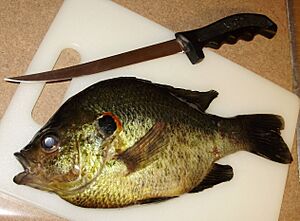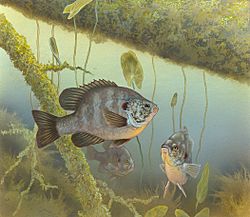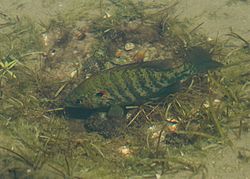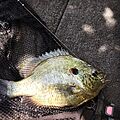Redear sunfish facts for kids
Quick facts for kids Redear sunfishTemporal range: Middle Miocene to Recent
|
|
|---|---|
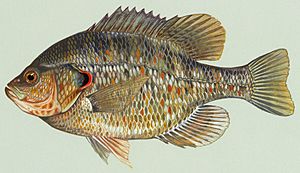 |
|
| Conservation status | |
| Scientific classification | |
| Synonyms | |
|
Pomotis microlophus Günther, 1859 |
The redear sunfish (Lepomis microlophus) is a freshwater fish found in lakes, ponds, and streams. It's also known by fun names like shellcracker, Georgia bream, and cherry gill. This fish is originally from the southeastern United States. Because it's a popular fish for sport fishing, people have moved it to many different waters across North America. The redear sunfish is famous for its special diet, which mainly includes mollusks and snails.
Contents
What Does a Redear Sunfish Look Like?
The redear sunfish looks a lot like the bluegill, but it's usually a bit bigger and has different colors. It has faint dark stripes running down its sides. The top of its body is dark, and its belly is a yellowish-green.
A cool way to tell males and females apart is by looking at their "ears." Males have a bright cherry-red edge on their gill cover, which looks like an ear. Females have an orange color in the same spot. Adult redear sunfish are usually between 20 and 24 centimeters (8 to 9.5 inches) long. The biggest ones can grow up to 43.2 centimeters (17 inches) and weigh about 0.45 kilograms (1 pound).
Where Do Redear Sunfish Live?
Redear sunfish are naturally found in places like North Carolina and Florida. Their native home stretches west to southern Illinois and southern Missouri, and south to the Rio Grande area in Texas. However, people have introduced them to many other parts of the United States.
In the wild, these fish love warm, calm waters in lakes, ponds, streams, and reservoirs. They like to hang out near sunken logs and plants. You'll often find them gathered in groups around these spots. They also live in many freshwater marsh wetlands.
What Do Redear Sunfish Eat?
The redear sunfish's favorite food is snails! These fish slowly move along the bottom of lakes, looking for snails and other creatures with shells. They use their strong jaws to crack open the shells.
Bigger redear sunfish mostly eat hard-shelled prey like tiny ostracods, small snails, and mussels all year round. Smaller redear sunfish also eat tiny water animals called zooplankton, amphipods, and different kinds of insect larvae. They might also eat algae, aquatic worms, and small fish.
Redears have special, thick teeth in their throat, called pharyngeal teeth. These teeth help them crunch through tough exoskeletons. They can even open small clams! Because they are so good at eating mollusks in deeper water, they can be put into lakes without competing with other fish that prefer shallower water or surface feeding.
Recently, people have started stocking redear sunfish in new places because they can eat quagga mussels. Quagga mussels are an invasive species that cause problems in many freshwater areas.
Reproduction and Life Cycle
During the breeding season, male redear sunfish gather together and build nests close to each other. Females then visit these nests to lay their eggs. Sometimes, redear sunfish will even hybridize (mix genes) with other types of sunfish.
Ancient History
The redear sunfish is the oldest known species in its fish family, Centrarchidae. Scientists have found fossils of redear sunfish that are as old as 16.3 million years! These fossils date back to a time called the Middle Miocene epoch.
Redear Sunfish and People
The International Game Fish Association (IGFA) keeps records of the biggest fish caught. The world record for a redear sunfish is 2.61 kilograms (5 pounds, 12 ounces). This huge fish was caught in Lake Havasu in Arizona in 2014.
Images for kids



